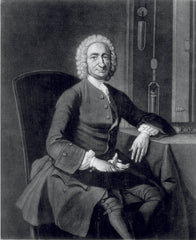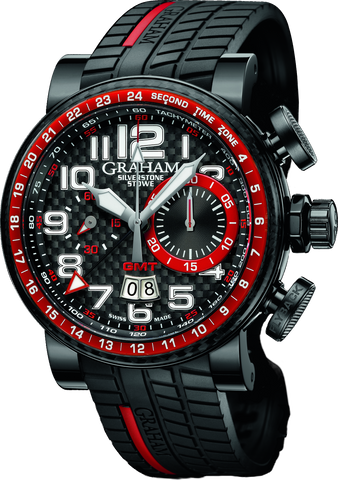About Graham Watches
Here at TimeScapeUSA we love to evangelize about our favorite brands, and Graham is a line that not many people in the States are acquainted with. It's a brand full of cloak and dagger, the delights of European hubris, and exotic space-age materials, and worth getting to know for the enthusiast of contemporary watchmaking with flair.
Graham What Now?
 George Graham was an 18th century English watchmaker working in London. The Graham Watch website claims he invented the chronograph – and it's an understatement to say that claim is hotly contested. But everyone agrees that he invented the dead-beat and cylinder escapements, two of the many intermediate constructions littering the evolution of the watch from the verge staff up until the standard pallet and escape wheel of today. Graham was a scientist first, and a significant figure in the history of British instrumentation and worldwide horological development.
George Graham was an 18th century English watchmaker working in London. The Graham Watch website claims he invented the chronograph – and it's an understatement to say that claim is hotly contested. But everyone agrees that he invented the dead-beat and cylinder escapements, two of the many intermediate constructions littering the evolution of the watch from the verge staff up until the standard pallet and escape wheel of today. Graham was a scientist first, and a significant figure in the history of British instrumentation and worldwide horological development.
Eric Loth Who?
But it doesn't take a keen eye to notice he wasn't Swiss. That honor falls to one Eric Loth, a 22 year veteran middle-manager and consultant in the watchmaking industry. So is Loth more than  just another hotshot with a masters degree in physical metallurgy? In 1995 he and his collaborators initiated The British Masters as a tribute to the great English watchmakers of the past, with Graham as their flagship brand. No word as to whether anyone involved was actually a citizen of Perfidious Albion, but for awhile in the early 2000's Loth made alliance with one Mr. Jean-Pierre Jaquet, a man famous for producing technical novelties using standard platforms.
just another hotshot with a masters degree in physical metallurgy? In 1995 he and his collaborators initiated The British Masters as a tribute to the great English watchmakers of the past, with Graham as their flagship brand. No word as to whether anyone involved was actually a citizen of Perfidious Albion, but for awhile in the early 2000's Loth made alliance with one Mr. Jean-Pierre Jaquet, a man famous for producing technical novelties using standard platforms.
The genesis of the Loth's project saw fierce efforts toward innovation and the slow consolidation of the Graham design aesthetic. Twenty years later, everyone is a little older and the brand has settled on peddling solid variations on the ETA 7750. With Mr. Loth's interests in advanced materials engineering, Graham pieces have a signature look – ample use of rubber, ceramic, aluminum, titanium, and carbon fiber offset by outré dial designs.
But I would be remiss if I didn't mention The Trigger.
The Trigger?
Every brand seeks to build in terms of a theme, an overarching aesthetic that signals to the world a
The Future
 As one would for a dinner guest who reveals a taste for monster trucks or Ayn Rand, one should avert one's gaze from Graham's hot tub forays with the National Hockey League. Is the institutionalized roughhousing of America's least important professional arena sport really the venue for haute horology? Is Kunal Nayar, a D list character actor on The Big Bang, a viable brand ambassador? At least Glenn Hughes, a man who briefly fronted Black Sabbath when I was still a sophomore in high school, was actually born in England.
As one would for a dinner guest who reveals a taste for monster trucks or Ayn Rand, one should avert one's gaze from Graham's hot tub forays with the National Hockey League. Is the institutionalized roughhousing of America's least important professional arena sport really the venue for haute horology? Is Kunal Nayar, a D list character actor on The Big Bang, a viable brand ambassador? At least Glenn Hughes, a man who briefly fronted Black Sabbath when I was still a sophomore in high school, was actually born in England.
At TimeScapeUSA we advise: stick to the watches. With its signature “Engineered” look, the patented Trigger, and the ETA 7750 (reliable like the older brother your parents secretly love more), Graham is still positioned to be a brand with a passionate following. Recent diversions like the Silverstone, inspired by auto racing, and marine models like the Prodive and Swordfish Booster, show that Eric Loth can still bring something new to the table.
1 Comment
Jovany
Sorry, I’m going to have to reply in English, because it will take me too long to try and write all this in Russian. I think the roasen the role of the chorus is so much more noticeable in this version of Faust is really because it is an oratorio, and not an opera, and it is therefore more rigidly structured, with the musical numbers carefully divided — you have the chorus scenes, and the scenes with the lead singers, carefully organized to make it easier to present in a concert, rather than a staged production.I think the chorus is more noticeable in baroque operas for much the same roasen — the musical scenes are carefully divided, and the plots are generally more simple, and carefully constructed to serve this more rigid musical structure.In operas of the romantic and modern period, the plots become much more elaborate and complex, and the music becomes less rigidly structured. The chorus is still present, but depending on the plot, it can be limited to just a few numbers, barely noticeable in the overall opera. Since the chorus usually represents a crowd of people, it’s harder to fit into an opera that is focused on the private actions of just a few people, like, say, La Traviata by Verdi. But in operas where crowds of onlookers are important, the chorus can still be just as important as before, and even play a pivotal role.I would say that Carmen is actually a good example of a more modern Western opera where the chorus still plays an extremely important role, since the crowd is such an large part of the story. The roasen I included that scene from Carmen is because it is one of the absolute most famous scenes from that opera, but when people talk about it, they generally don’t remember anything from it other than Carmen herself singing. And yet, when you watch the scene from the beginning, it becomes clear how pivotal a role the chorus plays. The chorus is just as important a part of that scene as Carmen — the scene wouldn’t work without it. And that is true for the opera as a whole, I think. If you want to look at it in purely quantitative terms, if you look at for Carmen, it becomes especially clear just how large a part the chorus plays in the action.So I would say that whether or not the chorus is important in modern operas does depend on the opera, but I don’t think it is fair to say that the chorus is always less important in modern Western operas than it was in the past. The action in the opera might be less structured, so the chorus might be mixed in more with the leads singing, so it’s less noticeable as a separate entity. But that doesn’t mean that it can’t be important in its own right.






Craig Zaligson
Author